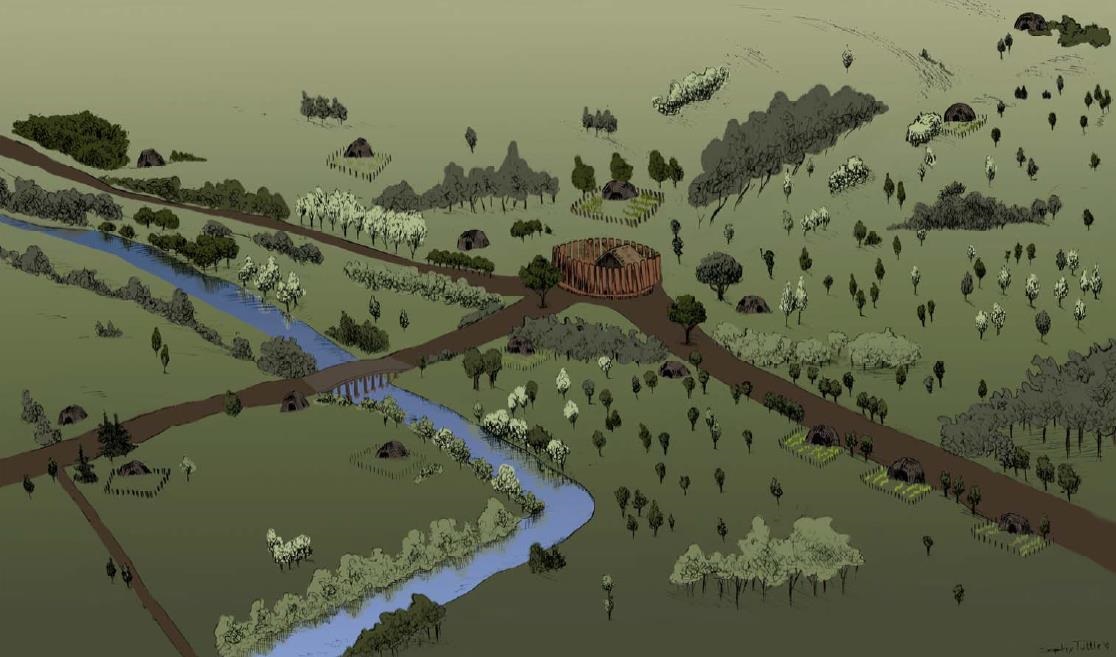
Algonquian Indians, with their leader, Waban, and Rev. John Eliot, a Puritan minister, created the first “Praying Indian Town” in Massachusetts at a bend in the Charles River that they named “Natick” in 1651.
The First “Praying Indian” Village
F.C. Detwiler’s conception of the layout of the original “Praying Indian Town” in South Natick, date unknown.
The Algonquian people who had lived along the river for thousands of years before the arrival of English colonists called it Quinobequin River, signifying its “meandering” or “circular” course during its 80-mile run to the ocean at the place that would become Boston. The English adventurer John Smith, who explored the Massachusetts Bay in 1614, named it the Charles River in honor of King James I of England
The river, which had been used for fishing and transportation for thousands of years, became a valuable asset on the site of the new settlement by Indian leaders and Rev. John Eliot. In a 1650 letter, Eliot wrote “I propounded unto [his Algonquian Indian friends] that they should look out some place to begin a towne…to search for a fit place…the Lord did by his speciall providence [guide us to] the place where we are at Natick.” That is the first documented reference to the name of our town, first given to the small farming settlement established in 1651.
One popular theory suggests that “Natick” means “a place of hills.” However, many language specialists and historians believe that a closer translation is “my land”, “a corner,” or “a clearing”. A more direct interpretation is that the name is derived from the Algonquian dialect words “nat” (“searching” or “seeking”) and “ick” (“a place”). The original village site on the river became known as South Natick.
With their leader, Waban, about 100 Algonquian Indians, many of them from an earlier settlement in Nonantum (now Newton), established the new Christian village on fertile land north and south of the river, with ready access to the water and nearby woodlands. They quickly built a bridge across the Charles River at the same site now occupied by the Pleasant Street bridge—the original 1650 structure was of wood on a stone foundation, about 80 feet long, with a 9-foot arch in the center. The modern bridge, built in 1861 and widened in 1903, is the latest of the structures that have spanned the river at that spot for almost 375 years.
As a condition for living in the new settlement, the Algonquian people had to agree to renounce their traditional way of life. They assented to living under English law and the Puritan religion. English-style agriculture got underway, with corn crops on fenced-in farms worked by Algonquian men and women who lived in English-style and traditional “wetu” houses. Apple orchards were planted, and fish weirs (traps) were built on the banks of the river. The first school for children, with a “Praying Indian” schoolmaster, was established in the meetinghouse. Eliot constructed the first meetinghouse inside a log palisade “fort” north of the river, now occupied by the historic Eliot Church. The white, two-story church at the intersection of Eliot, Union, and Pleasant Streets was erected in 1828. It is the fifth meetinghouse built on that site, which has been used continuously for nearly 375 years for worship services.
The colonial General Court initially granted the “Praying Indians” a parcel of 2,000 acres in 1651, which expanded in 1658 to 6,000 acres—today, the town of Natick has 10,300 acres. Algonquian people owned the land and worked the farms exclusively until the beginning of the 18th century when English colonists started taking the land as their own.
Selected sources and additional reading:
Natick Historical Society collections.
Crawford, Michael J. Natick: A History of Natick, Massachusetts. Natick, MA: Natick Historical Commission, 1978.

